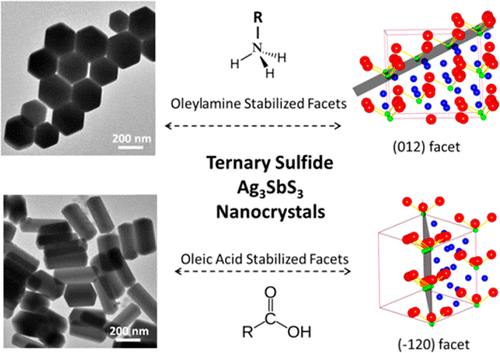当前位置:
X-MOL 学术
›
Cryst. Growth Des.
›
论文详情
Our official English website, www.x-mol.net, welcomes your feedback! (Note: you will need to create a separate account there.)
Shape Control of Ternary Sulfide Nanocrystals
Crystal Growth & Design ( IF 3.8 ) Pub Date : 2018-01-03 00:00:00 , DOI: 10.1021/acs.cgd.7b01355 Yanyan Xu 1 , Long Yuan 1 , Renguo Xie 2 , Lei Wang 3 , Qingshuang Liang 1 , Zhibin Geng 1 , Huanhuan Liu 1 , Keke Huang 1
Crystal Growth & Design ( IF 3.8 ) Pub Date : 2018-01-03 00:00:00 , DOI: 10.1021/acs.cgd.7b01355 Yanyan Xu 1 , Long Yuan 1 , Renguo Xie 2 , Lei Wang 3 , Qingshuang Liang 1 , Zhibin Geng 1 , Huanhuan Liu 1 , Keke Huang 1
Affiliation

|
Synthesis of semiconductor nanocrystals with a definite shape is the foundation of their anisotropy properties investigation; however, it is more challenging in ternary metal sulfides than that of noble metal and binary sulfides. In this paper, we report a solvent polarity control strategy to prepare a family of ternary sulfide (Ag3SbS3) semiconductor nanocrystals with tunable polyhedral shapes. The crystal growth speed along different directions was confined by the capping effect of the polarity of solvents that was defined by reaction temperature. Crystal shape of Ag3SbS3 nanocrystals could be tailored as a sphere, hexagonal plate, and prism. A shape-controllable growth mechanism was analyzed based on the Bravais–Friedel–Donnay–Harker theory by taking crystal structure characteristics and the polarity of solvents into consideration. The semiconductor nanocrystals show a near value of the band gaps for different shaped samples and facet-dependent photocatalytic water-splitting activities, which may result from the discrimination of the terminal surface structure and binding energy of Sb and S for the three different shaped nanocrystals. Thus, we provide a new crystal shape tunable strategy for ternary sulfide nanocrystal synthesis, which is important for optimizing properties and applications of sulfide semiconductor nanocrystals.
中文翻译:

三元硫化物纳米晶体的形状控制
具有确定形状的半导体纳米晶体的合成是其各向异性性质研究的基础。然而,三价金属硫化物比贵金属和二元硫化物更具挑战性。在本文中,我们报告了一种溶剂极性控制策略,以制备具有可调多面体形状的三元硫化物(Ag 3 SbS 3)半导体纳米晶体。沿不同方向的晶体生长速度受反应温度定义的溶剂极性的封端效应限制。Ag 3 SbS 3的晶体形状纳米晶体可以定制为球体,六边形板和棱镜。考虑到晶体结构特征和溶剂的极性,基于Bravais–Friedel–Donnay–Harker理论分析了形状可控的生长机理。半导体纳米晶体对于不同形状的样品显示出接近的带隙值,并且取决于面的光催化水分解活性,这可能是由于对三种不同形状的纳米晶体的末端表面结构以及Sb和S的结合能的区分所致。因此,我们为三元硫化物纳米晶体的合成提供了一种新的晶体形状可调策略,这对于优化硫化物半导体纳米晶体的性能和应用具有重要意义。
更新日期:2018-01-03
中文翻译:

三元硫化物纳米晶体的形状控制
具有确定形状的半导体纳米晶体的合成是其各向异性性质研究的基础。然而,三价金属硫化物比贵金属和二元硫化物更具挑战性。在本文中,我们报告了一种溶剂极性控制策略,以制备具有可调多面体形状的三元硫化物(Ag 3 SbS 3)半导体纳米晶体。沿不同方向的晶体生长速度受反应温度定义的溶剂极性的封端效应限制。Ag 3 SbS 3的晶体形状纳米晶体可以定制为球体,六边形板和棱镜。考虑到晶体结构特征和溶剂的极性,基于Bravais–Friedel–Donnay–Harker理论分析了形状可控的生长机理。半导体纳米晶体对于不同形状的样品显示出接近的带隙值,并且取决于面的光催化水分解活性,这可能是由于对三种不同形状的纳米晶体的末端表面结构以及Sb和S的结合能的区分所致。因此,我们为三元硫化物纳米晶体的合成提供了一种新的晶体形状可调策略,这对于优化硫化物半导体纳米晶体的性能和应用具有重要意义。

























 京公网安备 11010802027423号
京公网安备 11010802027423号